I hadn’t been to the library recently and I needed a new novel, so I stopped at our local bookstore. I breathe in the scent of new books as I enter the store. I glance at the bestselling books as I head towards the novels. I notice that many of the aisles where books used to be are filled with games and puzzles.
I roam the aisles and see a children’s Easter book display. I decide I’ll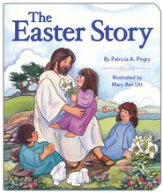 check this out since I like to buy my grandchildren a new Easter book every year. I’m looking for Easter books based on the real reason for Easter. I’m searching for engaging stories that depict Jesus’ triumphal entry on a baby donkey and other events.
check this out since I like to buy my grandchildren a new Easter book every year. I’m looking for Easter books based on the real reason for Easter. I’m searching for engaging stories that depict Jesus’ triumphal entry on a baby donkey and other events.
Like the book I gave my granddaughter Kylie, when she was seven-months-old, The Easter Story (2006). This 200 word board book for toddlers is by Patricia A. Pingry and illustrated by Mary Ann Utt. Kylie chewed on this book while I read her the story.
But after roaming several areas of the children’s department, I don’t see what I’m looking for. The clerk isn’t busy, so I inquire, “Do you have any religious Easter books for school-age children?”
“We have one board book, but that’s for younger children. Let me look around.”
The clerk checks different sections. Not finding anything she mentions, “I’m going to check the sales table. I’ll be back.”
I can never spend too much time browsing children’s books, so I don’t mind that she’s gone awhile. Spring is my favorite time of year so I continue flipping through the “Easter” books.
Some books feature cute stories about baby animals with precious drawings. Others are about egg hunts, the Easter bunny, silly stories, and spring. Today’s book special is Too Many Carrots.
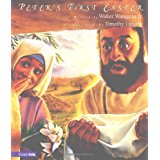 Where’s the beautifully illustrated book with breathtaking drawings, Peter’s First Easter (2000)? This book written by Walter Wangerin, Jr. and Timothy Ladwig, published by Zondervan is for 4 to 8 year-olds. Parents and grandparents, you’ll treasure this book too.
Where’s the beautifully illustrated book with breathtaking drawings, Peter’s First Easter (2000)? This book written by Walter Wangerin, Jr. and Timothy Ladwig, published by Zondervan is for 4 to 8 year-olds. Parents and grandparents, you’ll treasure this book too.
The clerk returns with the answer I get every spring when I inquire about Easter books. “We don’t have any other religious Easter books.”
“That’s really sad that you don’t have books about the true reason for Easter,” I reply. I think, maybe if more parents and grandparents requested these books, bookstores might start carrying “The True Story of Easter” alongside Too Many Carrots.
How will children learn about the crucifixion and resurrection of Jesus in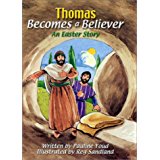 a culture focused on eggs and bunnies? Where’s the book Thomas Becomes a Believer: An Easter Story (2002) written by my author friend, Pauline Youd and illustrated by Reg Sandland. This book published by Zondervan is for children 6 and up.
a culture focused on eggs and bunnies? Where’s the book Thomas Becomes a Believer: An Easter Story (2002) written by my author friend, Pauline Youd and illustrated by Reg Sandland. This book published by Zondervan is for children 6 and up.
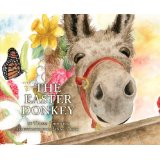 And how will children know that they can accept God’s Easter gift by believing in Jesus? “The Easter Donkey (2014) offers a fresh telling of the Easter story while reminding readers of its wonder. The Easter Donkey tells of Drupelet’s journey to understand the gifts God has given to those who accept them,” (Amazon Books).
And how will children know that they can accept God’s Easter gift by believing in Jesus? “The Easter Donkey (2014) offers a fresh telling of the Easter story while reminding readers of its wonder. The Easter Donkey tells of Drupelet’s journey to understand the gifts God has given to those who accept them,” (Amazon Books).
This story is written from the donkey’s perspective as he travels with Jesus during what we now call Holy Week. This book by author Donna Thornton along with illustrator Lynne Ballenger Pryor is published by Ambassador International.
How will you teach your children and grandchildren about the real Easter Story? The books I’ve featured are some of my favorites to share with my grandchildren.
But this year, our two oldest grandchildren, who are first and second 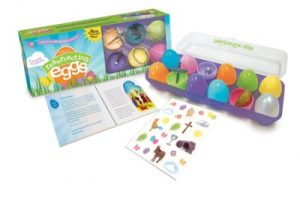 graders, are using Resurrection Eggs to tell the Easter story. Both grandkids are early readers so they read the booklet’s description and find the corresponding item that goes in each egg. Then they re-tell the story again as they take each item out of the egg so the sibling can read the story.
graders, are using Resurrection Eggs to tell the Easter story. Both grandkids are early readers so they read the booklet’s description and find the corresponding item that goes in each egg. Then they re-tell the story again as they take each item out of the egg so the sibling can read the story.
Interestingly, this is the 20th anniversary of the Resurrection Egg. There are several versions of these available including one that is a “do it yourself” project for children. The great thing about the eggs is that they are a hands-on way to learn.
No matter how you choose to tell children about the real Easter story, the important part is that you tell the story of hope over and over again. As children get older they understand more of the complexities of Jesus dying on the cross and three days later rising from the dead. Have a blessed Easter.
